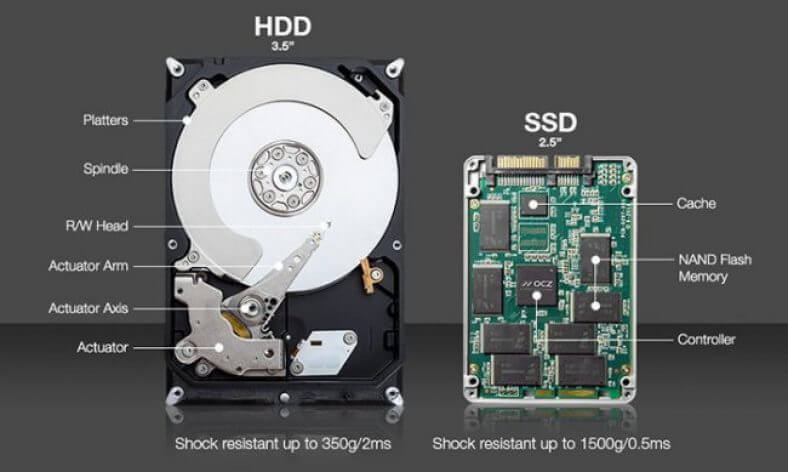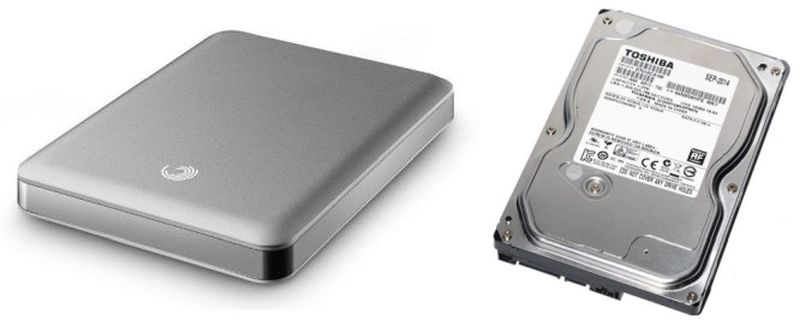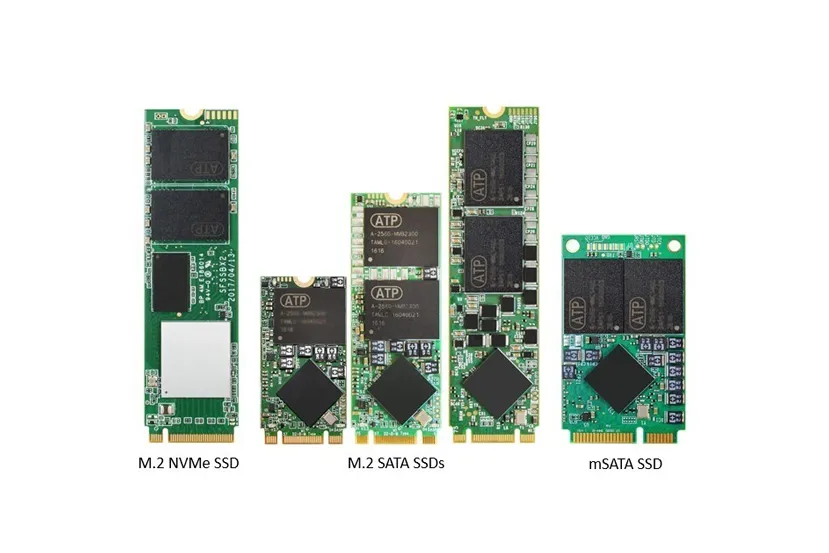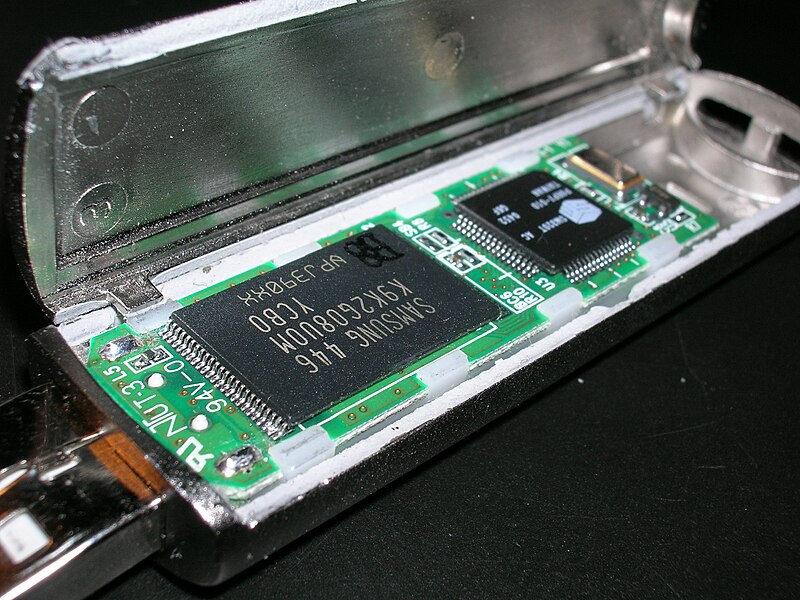Hard Disk
|
Gli hard disk, o dischi rigidi, sono componenti fondamentali all’interno di ogni computer, tablet, cellulare e qualsiasi dispositivo elettronico. |
|
|
|
Vengono comunemente identificati come hard disk drive, o con le sigle abbreviate HDD o HD (alcune volte indicati erroneamente come hard disc). Sono dei dispositivi per l’archiviazione di massa che funzionano con dei dischi magnetizzati in grado di archiviare i dati che vengono messi al loro interno. Senza hard disk difficilmente un computer potrebbe funzionare correttamente e mantenere i dati che ogni giorno salviamo al suo interno. Sono stati finora utilizzata su tutti i computer e dispositivi portatili, ma negli ultimi anni si è vista una crescente diffusione di hard disk di nuova generazione, più veloci e preformanti degli Hard disk Sata, e di questi dischi (gli SSD) cui parleremo più avanti. Gli hard disk, oggi, hanno raggiunto capacità altissime e velocità impensabili solo 5 anni fa, c’era una continua corsa a migliorare processori, ram e frequenze in generale e l’HD rimaneva sempre un pò il collo di bottiglia. La funzione degli hard disk (a volte anche chiamato hard hd ) è proprio quella di conservare i dati, file, programmi e quant’altro, sono dei dispositivi per l’archiviazione indispensabili e molto importanti. Più sono capienti e più è possibile accumulare file all’interno. Esistono sostanzialmente due tipi di hard disk, quelli interni e quelli esterni. |
|
|
|
Il disco rigido solitamente nei computer fissi è interno, e serve a contenere il sistema operativo, i programmi e tutti gli altri files che di volta in volta vengono caricati o salvati. Nei computer fissi gli hard disk hanno dimensioni di 3,5 pollici, mentre per l’hard disk portatile è necessario, per via delle dimensioni contenute, installare hard disk di dimensioni inferiori, solitamente di 2,5 pollici. A volte però gli hard disk interni potrebbero danneggiarsi, con il rischio di perdere dati preziosi, per questo è importante prendere in considerazione l’utilizzo di unità esterne per archiviare i propri documenti e tutto ciò che riteniamo importante.
Gli hard disk esterni, come anticipato poco fa, servono proprio per archiviare in maniera sicura i propri dati, e il più delle volte la loro capienza ci permette di salvare tutto ciò che è contenuto all’interno del computer. In pratica è come se fossero una memoria esterna per pc, e sono davvero fondamentali per effettuare il backup in maniera sicura. In questa maniera possiamo avere copie pronte all’uso e in sicurezza dei nostri dati più importanti, nel caso il computer subisca qualche danno. Gli hard disk esterni non sono altro che normali hard disk HDD o SSD, delle dimensioni di 2,5 pollici, che possono essere trasportati con facilità, e collegati all’occorrenza al portatile tramite cavetto USB. Questi hard disk esterni vengono sostanzialmente usati in due modi o come memoria esterna pc oppure come back up di riserva. |
|
|
|
Gli hard disk esterni sono fondamentali per i computer desktop ma lo sono ancora di più per i notebook. Un hard disk per portatile può davvero salvarci la vita se il portatile si rompesse oppure se venisse perso il Pc. Spesso la portabilità dei notebook è utilissima ma il fatto di portarli in giro li espone e più rischi rispetto ad un pc desktop che è fermo a casa o in ufficio ecco perché un back up con hard disk per notebook ci può aiutare moltissimo. Solitamente sono contenuti all’interno di un involucro che può essere di plastica o di alluminio. Quest’ultimo materiale è il più adatto per proteggere l’hard disk, in quanto consente di dissipare il calore in maniera più efficace. Gli hard disk esterni hanno, alla stregua di quelli interni, capacità di archiviazione differenti che vanno da un range di 500 Gb a 3-4 Tera di memoria. Possono essere del tipo HDD o SSD, i primi indubbiamente più economici dei secondi e con prestazioni meno elevate. Gli hard disk SSD sono dei nuovi dispositivi di archiviazione, che fanno uso di memorie flash al posto dei dischi magnetici utilizzati finora. |
|
|
|
Gli Hard disk SSD o Solid State Disk, non sono un’evoluzione dei classici hard disk, bensì un’alternativa per l’archiviazione dei dati. La differenza sostanziale tra le due tipologie di dischi sta nel fatto che mentre gli HDD sono pensati per avere una grande capacità di archiviazione, quindi molti GB o Terabyte a disposizione, gli SDD sono concepiti per essere più sicuri, veloci e migliorare le prestazioni della macchina su cui sono montanti. Difatti non a caso quando si sostituisce un HDD con un SSD i computer girano molto più velocemente, caricando i dati in un batter d’occhio, anche quando il disco si riempie. A differenza dei normali HD che rallentano quando diventano sovraccarichi di dati. Un’altra differenza sostanziale con gli HDD sta nella tipologia di struttura: mentre gli HDD hanno piatti di rotazione e testine per poter funzionare, gli SSD sono privi di parti meccaniche, e grazie a questo vantaggio risulta anche più difficile il loro danneggiamento. L’unico inconveniente degli SSD è il loro ciclo di vita, che solitamente è di 5-6 anni, anche se gli ultimi modelli hanno aumentato di molto la loro vita media. Oggi gli hard disk notebook hanno iniziato a montare gli SSD come disco primario, alcuni addirittura hanno hd interno secondario in Sata per immagazzinare i dati Nella categoria degli SSD, rientrano anche gli Hard disk Sata M.2 che rappresentano l’ultimissima evoluzione in termini di tecnologia e sono molto piccoli e sono adattissimi per i portatili in quanto si parla di Hard disk più piccoli di una Penna USB. |
|
|
|
Raggiungono velocità assurde e sono un must per chi ha un pc da Gaming, in quanto le prestazioni rendono possibile anche i giochi di ultima generazione con risoluzioni alte. L’attacco M.2 sostituisce gli mSATA che prima avevano un posto predominante sui notebook. Come dicevamo il punto di forza di questi Hard disk è la velocità, per fare un piccolo confronto la velocità di trasferimento di un SATA non supera 770MB/s più o meno. Per capire la velocità di questi Hard disk M.2 hanno una velocità di velocità di lettura/scrittura di 3500MB/s i più performanti mentre la fascia media arriva tranquillamente a 1500MB/s che è comunque il doppio di un SSD SATA. L’installazione di un hard disk M2 è molto semplice, l’attacco è molto veloce e sulle schede madri con la predisposizione è molto ben visibile, le schede madri Asus più performanti hanno anche la possibilità di mettere un piccolo dissipatore sopra l’hard disk.
Esiste poi un’altra tipologia di archiviazione chiamata NAS. Questo è un particolare tipo di dispositivo di archiviazione che permette di memorizzare e condividere i dati attraverso la rete, (alcuni modelli tramite wi-fi), con computer, smartphone e altri apparecchi ad esso connessi. |
|
|
|
NAS è l’acronimo di Network Attached Storage, cioè un sistema di archiviazione collegato alla rete. Il NAS viene collegato ad un router e tramite esso viene creata una rete condivisa con gli altri dispositivi, questi possono quindi accedere alle varie unità di archiviazione in esso contenute. Gli hard disk per NAS sono diversi rispetto agli hard disk tradizionali, in quanto prediligono la durata della loro funzione, a discapito della velocità. Per intenderci il NAS diventa una sorta di Server o Cloud privato. Il NAS può essere considerato come un vero e proprio computer che funziona tramite alimentazione elettrica, e possiede un sistema operativo per le varie funzioni, solitamente basato su tecnologia Linux. Ogni NAS storage è dotato oltre che dell’alimentatore, anche di una CPU, una RAM, i moduli di rete per la connessione internet tramite cavo o Wi-Fi, la memoria per il sistema operativo e diversi slot per l’alloggiamento dei vari hard disk. Le versioni più economiche solitamente dispongono di due alloggiamenti, ma è possibile avere soluzioni più costose e complesse con più di mezza dozzina di slot per gli hard disk. Alcuni NAS possono avere porte USB, piuttosto utili e veloci in alcuni casi. |
|
Hai un problema con uno di questi dispositivi?MrDisk è un Laboratorio Specializzato nel Data Recovery dotato di tutta la strumentazione necessaria per consentire il ripristino dei dati persi da qualsiasi tipologia di caso ci venga presentato.
Nei nostri laboratori operano solamente tecnici specializzati e con anni di esperienza nel campo del recupero dati professionale, al fine di offrire ai nostri clienti il miglior servizio possibile.
Alcune caratteristiche importanti:
E’ possibile il totale recupero dati nei seguenti casi:
Il procedimento del recupero dati in camera bianca si suddivide in due fasi: la fase di diagnosi e la procedura di recupero dati. Il cliente viene costantemente informato sullo stato del recupero dati.
Richiedi un'analisi gratuita cliccando sulla pagina contattaci! |

Subcategories
-
2.5 inch Magnetic Disks
The two main formats that determine the size of the hard disks are 3.5 inch hard disk for desktop computers and 2.5 inch hard disk mainly used for laptops.
The2.5″ hard disk precisely for their use in laptops, they are designed with the aim of consuming less energy, although sometimes at the expense of other functionality.
The differences between 2.5" and 3.5" hard disk formats should not be underestimated. The 2.5" HD, in fact, they typically have less memory capacity, less cache and slower speed when compared to similarly priced 3.5" hard drives.
For example, a 3.5″ hard disk can store over 12 TB (terabyte) of data, have more than 128 MB of cache and go from 7200 to even 10000 rpm. But the problem is that it typically consumes around 5W which it's ok for a desktop PC but is definitely too much for battery-powered laptops.
A large 2.5" HD also reaches 4 TB, 16 or 32 MB of cache. The revolutions number for minute is usually 5400, but it can still reach 7200 and their consumption is lower, up to 2.5 W in some models.
More the technology advances, more these data change but the thing that remains unchanged is the constant difference between the performance of 2.5″ and 3.5″ hard disks in the same price range. A 2.5″ high performance HD costs much more than a 3.5" high performance one, even if its performance is only comparable to a lower-end 3.5″ one.
An advantage of 2.5″ hard drives, however, is their resistance to vibrations compared to 3.5 ones. For example, some 2.5″ hard drives have internal accelerometers that detect when they are about to fall, securing the disk head to minimize damage. This feature is rare for 3.5″ hard drives which are usually intended for desktop computers that are designed not to be moved when working.
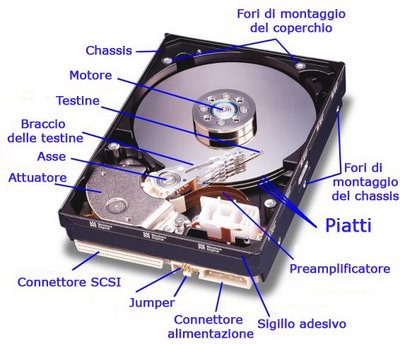
Thehard disk is basically made up of one or more rapidly rotating plates, made of aluminum or glass, covered with ferromagnetic material and two heads for each platter (one on each side), which, during operation, "fly" at a distance of a few tens of nanometers from the disk surface, reading or writing the data. The head is kept raised by the air moved by the rotation of the discs whose frequency or rotation speed can exceed 15,000 revolutions per minute; currently the standard rotation values are 4,200, 5,400, 5,980, 7,200, 10,000 and 15,000 revolutions for minute.
) The storage or writing of information or data on the surface of the ferromagnetic support essentially consists in the transfer of a certain direction to the magnetization of a certain number of Weiss domains. A bit of information (1 or 0) is associated with a certain state (direction) of magnetization. The number of Weiss domains that make up a single bit, multiplied by their average surface extension, compared to the available storage surface, provides the information density (bits per square inch). Therefore, cramming a greater quantity of data on the same disk requires reducing the number of domains that contribute to the definition of a single bit and/or reducing the area of a single magnetic domain.
The continuous evolution of hard disk technology has now brought us close to the tolerable lower physical limit: when in fact the number of domains that define a single bit has approached unity and their area is of the order of a few square nanometres, the thermal energy of the system has now become comparable to magnetic energy and a very short time is sufficient to reverse the direction of the magnetization of the domain and lose the information contained.
In the past, the reading/writing of magnetic information was entrusted to inductive heads, miniaturized copper windings capable of detecting, during the reading phase and according to the principle of magnetic induction, the variation in the flow of the static magnetic field as the head passes between one bit and the next of a track containing the bits, or in a dual manner impressing a magnetization on the disk being written.
The evolution that spintronics brought into everyone's homes were the magnetoresistive heads, based on a device, the spin-valve, capable of varying resistance as the intensity of the magnetic field changed. The advantage given by these heads lies in their sensitivity, better than the old inductive heads, and in their very small size, which allows you to follow the pace of evolution towards the nanometer regarding the area of a single bit. Finally, the near future will see reading heads based on magnetic tunneling junctions, MTJ, as protagonists of the scene.
Typically for the storage of digital data the hard disk requires the preliminary operation of logical formatting with choice of the particular logical data storage system to be used known asfile system, through which the operating system is able to write andrecovery data.

The data, at the physical level, are generally stored on disk following a well-defined physical allocation scheme based on which the area where the data can be read/written on the disk can be reached. One of the most widespread is the so-called CHS, acronym for the English term Cylinder/Head/Sector (Cylinder/Head/Sector); in this structure the data is stored with a number as physical address for each of the following physical entities:
Platter: a hard disk is composed by one or more parallel disks, called "platters", and each side of the platters is identified by a unique number; for each plate there are two heads, one for each of the two sides.
Head: on each platter there is a head for each side of the same, for writing or reading access to the stored data; the position of this head is integral with all the others on the other platters. In other words, if a head is placed above a track, all heads will be placed in the cylinder to which the track belongs.
track(A): each plate is made up of numerous numbered concentric rings, called tracks, each identified by a unique number.
Geometric sector (B): each plate is divided into equal radial "slices", each identified by a unique number.
Cluster (D): set of contiguous track sectors.
Cylinder: the set of tracks at the same distance from the center present on all discs or platters is called a cylinder. Matches all tracks with the same number, but different plate.
Block:
The set of sectors placed in the same position in all plates.CHS, expressible by indicating cylinder, head, sector. In this way it is possible to uniquely address each block of data on the disk. For example, if a hard disk is made up of 2 disks (or equivalently 4 platters), 16384 cylinders (or equivalently 16,384 tracks per platter) and 16 sectors, and each sector of a track has a capacity of 4096 bytes, then the capacity of the disk will be 4 × 16384 × 16 × 4096 bytes, i.e. 4 GB.
The interleaving factor is the number of sectors of the hard disk that must be skipped to consecutively read all those of the track. This strictly depends on the performance characteristics of the hard disk itself, i.e. the rotation speed of the disk, the movement of the seekers with their heads and the read-write speed of the head itself.
This process was introduced because initially the CPUs, which received and reprocessed the read data, performed these actions at a speed lower than the reading/writing speed on the hard disk, therefore, once the data coming from a sector had been reprocessed, the head would already be beyond the beginning of the next sector. By alternating sectors regularly and reading them according to the specific interleaving factor, the hard disk and the computer were speeded up. Modern hard drives do not require interleaving.

Thesectoris the smallest unit of the low-level formatting that concerns the physical structure of the hard disk (physical formatting not to be confused with the logical formatting that concerns the creation of the file allocation tables [FAT] necessary for the operating system to manage and navigate the data present in the disk folders). Generally, industries are logically grouped into clusters for efficiency reasons, so when we talk about clusters we are referring to a group of industries. Remember that a file always occupies at least one cluster. To access a sector you must specify the surface (platter), the track and the sector itself. The sector is not a simple space on the storable disk, but is also equipped with a particular structure which can be linearly summarized as follows (the size of a sector varies between 32 bytes and 4 KB, usually 512 bytes):
. The IRG is InterRecordGap, that is, the demagnetized part of the trace that serves to announce the beginning of the sector (or its end). The part named "SYN,SYN" are known bytes for the read clock, i.e. they serve to synchronize a current read clock, generated by the combined PLL and VCO, with the original write clock. At the center is the "HEADER", part of the sector where the information necessary for locating the same sector on the entire hard disk is stored, i.e. where the head is reading-writing at that moment. Certainly the most important part is the "DATA" one, that is, where the data has been packaged through records so that the ratio between "useful" data and information is high: the data allocated in the sector must be greater than the allocation information of the sector itself. Another important part of the structure of a sector is the "BCC", block check character. This part of the sector is the result of a function calculated on the "data" block and its purpose is to confirm the correct reading of the information, i.e. the data, and to make clear any reading error.
The commercial name Advanced Format has recently been introduced, all manufacturers apply a special irrefutably discernible logo on all hard disks that have sectors larger than 512 bytes using this common name. Each manufacturer adopts a peculiar structure for the individual sectors of the AF disks which contains, in addition to parts homologous to those described, a real CRC and other proprietary construction parameters depending on the model and intended use of the specific product.
Do you have a problem with one of these devices?
MrDisk is a Specialized Laboratory in Data Recovery equipped with all the necessary equipment to allow therestore lost data from any type of case presented to us.
.jpg)
In our laboratories only work specialized technicians with years of experience in the field of professional data recovery, to offer our customers the best possible service.
Some important features:
- Possibility to have adedicated technician to your case
- Constant research and development activity
- Specialized technicians on individual media or brands
- Possibility of even extreme interventions in a clean room
- Possibility of receiving real-time updates on the processing progress
Total data recovery is possible in the following cases:
- Logical damage (software): where the media is still recognized by the system BIOS.
- Physical damage, both electrical, electronic or mechanical (hardware): in which the media is or not longer recognized by the BIOS.
data recovery process in a clean room is divided into two steps: the diagnosis step and the data recovery procedure.
The customer is constantly informed about the status of data recovery.
Request a free analysis by clicking on the page contattaci!
-
3.5 inch Magnetic Disks
Modern hard drives have capacity and performance enormously higher than those of the first models, but since in the meantime the speed and performance of random access memories (RAM and ROM) have increased much more, their speed in reading and writing data however, they remain several orders of magnitude below the performance of RAM and the solid state components that equip a computer. For this reason the hard disk is often the main cause of the slowdown of a computer (bottleneck) especially when, due to a RAM memory lower than the virtual memory required by the running programs, the operating system is forced to perform a large number of swap operations between disk and main memory.
Themain performance characteristics of a hard drive are:
- storage capacity;
- data access time;
- i.
the data transfer speed.Thestorage capacity is typically expressed in gigabytes (GB). Manufacturers use decimal gigabytes, rather than the power-of-two approximations used for memory. This means that the capacity of a hard drive is actually a little smaller than that of a memory module of the same capacity, and the gap increases as the size increases. When the capacity is expressed in GB, the correction factor is (1000/1024)3, equal to approximately 0.93, so a 320 GB hard drive has an effective capacity of approximately 298 GiB. Currently (April 2017) hard drives are on sale with capacities up to 10 TB. Some companies combine multiple disks in a single box, this is an expedient to offer maximum storage capacity in the minimum space, for example: Lacie Big Disk, Maxtor Shared Storage, etc. The capacity can be increased by increasing the density with which the information is stored on the plates that make up the hard disk or by using a greater number of them. /p>
Theaccess time is the most important variable in determining the performance of a hard disk (knowing the model you can easily trace the technical data of the unit including the access time; many computer manufacturers do not mention this data and sometimes not even the brand and model) . This is the average time necessary for data, residing in a random point on the disk, to be found. The time taken depends on the speed of the head moving on the track where the data resides and on the rotation speed of the disk; the higher the speed, the shorter the time it takes for the data to pass back under the head if it had not reached the data in time during the previous rotation (rotational latency). Manufacturers therefore try to create ever lighter heads (which can move faster because they have less inertia) and discs that spin faster. Typical access time for a 7200 rpm hard drive is about 9 milliseconds (ms), for a 15,000 rpm hard drive it is less than 4 ms.
Thetransfer speedis the amount of data provided by the hard disk in a given time (usually 1 second is taken as a reference). Using disks that spin faster or increasing storage density leads to a direct improvement in transfer speed. It should be remembered that the transfer speed drops proportionally to the number of discontinuities in the sectors that make up the searched file (see fragmentation).
More to the three above, other characteristics affect the performance of a hard drive to a lesser extent. Like these:
- The memory buffer;
- The interface speed.
Thebuffer is a small cache memory (usually a few megabytes) placed on board the hard disk, which has the task of storing the latest data read or written from the disk. If a program repeatedly reads the same information, it may be found in the buffer instead of on disk. Since the buffer is an electronic and not mechanical component, the transfer speed is much greater, over time, the capacity of this memory has always increased, currently (April 2017) 64 MB or even 128 MB is a fairly usual size, up to reach up to 256 MB in the top models.
Theconnection interface between the hard drive and the motherboard (or, more specifically, the controller) can affect performance because it specifies the maximum speed at which information can be transferred to or from the drive. Modern interfaces such as ATA133, Serial ATA or SCSI can transfer hundreds of megabytes per second, much more than any single hard drive can do, and so the interface is generally not a limiting factor. The situation may change when using multiple disks in a RAID configuration, in which case it is important to use the fastest possible interface, such as 2 Gb/s Fiber Channel.
The disk access time , more, is influenced by five factors:
Controller Overhead: is the time necessary to manage the data and send the appropriate interrupt; it is the absolute shortest time;
Seek time: is the time necessary to move the head on the track; it is the most critical factor since it is a mechanical movement and not an electrical impulse; this means that it cannot go below a few tens of milliseconds;
Assessment time: is the time necessary for the head to settle on the track after the movement; it is often incorporated into Seek time;
Latency time: (also rotational latency) is the time necessary for, due to the rotation of the disk, the beginning of the desired sector to arrive under the head; obviously it depends on the speed of the spindle; for example with a (typical) speed of 5400 rpm, the maximum latency time is approximately 11 milliseconds;
Rotational time: is the time necessary for the sector to pass under the head, time during which the sector is read or written.
Access time: Controller Overhead + Seek Time + Latency + Rotational Time

For example, a 3.5″ hard disk can store over 12 TB (terabytes) of data, have more than 128 MB of cache and go from 7200 to even 10000 revolutions per minute. The problem however is that it typically consumes around 5W which is fine for a desktop PC but is definitely too much for a battery powered laptop.
A large 2.5″ hard disk also reaches 4 TB and 16 or 32 MB of cache. The number of revolutions per minute is typically 5400 but can still reach 7200 and their consumption is lower, up to 2.5 W in some models.
More technology advances, more these data change but the thing that remains unchanged is the constant difference between the performance of 2.5″ and 3.5″ hard disks in the same price range. A high-performance 2.5" hard disk costs much more than a high-performance 3.5" one even if its performance is only comparable to a lower-end 3.5" hard disk.
An advantage of 2.5″ hard drives, however, is their resistance to vibrations compared to 3.5 ones. For example, some 2.5″ hard drives have internal accelerometers that detect when they are about to fall, securing the disk head to minimize damage. This feature is rare for 3.5" hard drives which are usually intended for desktop computers that are designed not to be moved when working.

Thehard disk it is basically made up of one or more rapidly rotating plates, made of aluminum or glass, covered with ferromagnetic material and two heads for each platter (one on each side), which, during operation, "fly" at a distance of a few tens of nanometers from the disk surface, reading or writing the data. The head is kept raised by the air moved by the rotation of the discs whose frequency or rotation speed can exceed 15,000 revolutions per minute; currently the standard rotation values are 4,200, 5,400, 5,980, 7,200, 10,000 and 15,000 revolutions per minute.
The storage or writing of information or data on the surface of the ferromagnetic support essentially consists in the transfer of a certain direction to the magnetization of a certain number of Weiss domains. A bit of information (1 or 0) is associated with a certain state (direction) of magnetization. The number of Weiss domains that make up a single bit, multiplied by their average surface extension, compared to the available storage surface, provides the information density (bits per square inch). Therefore, cramming a greater quantity of data onto the same disk requires reducing the number of domains that contribute to the definition of a single bit and/or reducing the area of a single magnetic domain.
The continuous evolution of hard disk technology has now brought us close to the tolerable lower physical limit: when in fact the number of domains that define a single bit has approached unity and their area is of the order of a few square nanometres, the thermal energy of the system has now become comparable to magnetic energy and a very short time is sufficient to reverse the direction of the magnetization of the domain and thus lose the information contained./p>
In the past, the reading/writing of magnetic information was entrusted to inductive heads, miniaturized copper windings capable of detecting, during the reading phase and according to the principle of magnetic induction, the variation in the flow of the static magnetic field as the head passes between one bit and the next of a track containing the bits, or in a dual manner impressing a magnetization on the disk being written.
The evolution that spintronics brought into everyone's homes were the magnetoresistive heads, based on a device, the spin-valve, capable of varying resistance as the intensity of the magnetic field changed. The advantage given by these heads lies in their sensitivity, better than the old inductive heads, and in their very small size, which allows you to follow the pace of evolution towards the nanometer regarding the area of a single bit. Finally, the near future will see reading heads based on magnetic tunneling junctions, MTJ, as protagonists of the scene.
Typically for the storage of digital data the hard disk requires the preliminary operation of logical formatting with choice of the particular logical data storage system to be used known asfile system,through which the operating system is able to write and recover data.

The data, at the physical level, are generally stored on disk following a well-defined physical allocation scheme based on which the area where the data can be read/written on the disk can be reached. One of the most widespread is the so-called CHS, acronym for the English term Cylinder/Head/Sector;in this structure the data is stored with a number as physical address for each of the following physical entities:
Platter: an hard disk is made up of one or more parallel disks, called "platters", and each side of the platters is identified by a unique number; for each plate there are two heads, one for each of the two sides.
head: on each platter there is a head for each side of the same, for writing or reading access to the stored data; the position of this head is integral with all the others on the other platters. In other words, if a head is placed above a track, all heads will be placed in the cylinder to which the track belongs.
tracks (A):each plate is made up of numerous numbered concentric rings, called tracks, each identified by a unique number.
Geometric sector (B): each plate is divided into equal radial "slices", each identified by a unique number.
Cluster (D): set of contiguous track sectors.
Cylinder: the set of tracks at the same distance from the center present on all discs or platters is called a cylinder. Matches all tracks with the same number, but different plate.
Block: The set of sectors placed in the same position in all plates.
This structure introduces a physical geometry of the disk that consists of a series of "coordinates"CHS, expressible by indicating cylinder, head, sector. In this way it is possible to uniquely address each block of data on the disk. For example, if a hard disk is made up of 2 disks (or equivalently 4 platters), 16384 cylinders (or equivalently 16,384 tracks per platter) and 16 sectors, and each sector of a track has a capacity of 4096 bytes, then the capacity of the disk will be 4 × 16384 × 16 × 4096 bytes, or 4 GB.
The interleaving factor is the number of sectors of the hard disk that must be skipped to consecutively read all those of the track. This strictly depends on the performance characteristics of the hard disk itself, i.e. the rotation speed of the disk, the movement of the seekers with their heads and the read-write speed of the head itself./p>
This process was introduced because initially the CPUs, which received and reprocessed the read data, performed these actions at a speed lower than the reading/writing speed on the hard disk, therefore, once the data coming from a sector had been reprocessed, the head would already be beyond the beginning of the next sector. By alternating sectors regularly and reading them according to the specific interleaving factor, the hard disk and the computer were speeded up. Modern hard drives do not require interleaving./p>

Thesector is the smallest unit of the low-level formatting that concerns the physical structure of the hard disk (physical formatting not to be confused with the logical formatting that concerns the creation of the file allocation tables [FAT] necessary for the operating system to manage and navigate the data present in the disk folders). Generally, industries are logically grouped into clusters for efficiency reasons, so when we talk about clusters we are referring to a group of industries. Remember that a file always occupies at least one cluster. To access a sector you must specify the surface (platter), the track and the sector itself. The sector is not a simple space on the storable disk, but is also equipped with a particular structure which can be linearly summarized as follows (the size of a sector varies between 32 bytes and 4 KB, usually 512 bytes):
. L'IRG è InterRecordGap, that is, the demagnetized part of the trace that serves to announce the beginning of the sector (or its end). The part named "SYN,SYN" are known bytes for the read clock, i.e. they serve to synchronize a current read clock, generated by the combined PLL and VCO, with the original write clock. At the center is the "HEADER", part of the sector where the information necessary for locating the same sector on the entire hard disk is stored, i.e. where the head is reading-writing at that moment. Certainly the most important part is the "DATA" one, that is, where the data has been packaged through records so that the ratio between "useful" data and information is high: the data allocated in the sector must be greater than the allocation information of the sector itself. Another important part of the structure of a sector is the "BCC", block check character. This part of the sector is the result of a function calculated on the "data" block and its purpose is to confirm the correct reading of the information, i.e. the data, and to make clear any reading error.
The commercial name Advanced Format has recently been introduced, all manufacturers apply a special irrefutably discernible logo on all hard disks that have sectors larger than 512 bytes using this common name. Each manufacturer adopts a peculiar structure for the individual sectors of the AF disks which contains, in addition to parts homologous to those described, a real CRC and other proprietary construction parameters depending on the model and intended use of the specific product.
Have you got a problem with one of these devices?
MrDisk is a Specialized Laboratory in Data Recovery equipped with all the necessary equipment to allow the restore lost data from any type of case presented to us.
.jpg)
In our laboratories work only specialized technicians and with years of experience in the field of the professional recovery data, to offer our customers the best possible service.
Some important features:
- Possibility of having adedicated technician to your case
- Constant research and development activity
- Specialized technicians on individual media or brands
- Possibility of even extreme interventionsclean room
- Possibility to having real-time updates on the progress
Total data recovery is possible in the following cases:
- Logical damage (software): where the media is still recognized by the system BIOS.
- Physical damage, whether electrical, electronic or mechanical (hardware): where the media is or not longer recognized by the BIOS.
The recovery data procedure in a clean room is divided into two steps: the diagnosis step and the data recovery procedure.
The customer is constantly informed about the status of data recovery
Request a free analysis by clicking on the page contattaci!
-
External USB disks
Theexternal hard drive is an input/output peripheral of a computer or storage device that is used for storing any type of file.
It is generally composed of a normal hard disk, inserted into a special one caseequipped with connection ports to a personal computer. Various connection technologies have been used such asUSB, FireWire, SCSI, eSATA.
External hard disk drives are usually available as pre-assembled integrated products, but can also be assembled by combining an external enclosure (with USB or other interface) with a separately purchased drive. They are available in 2.5-inch and 3.5-inch sizes; The 2.5-inch variants are typically called portable external drives, while the 3.5-inch variants are referred to as desktop external drives. "Portable" drives are packaged in smaller, lighter cases than "desktop" drives; Additionally, "portable" drives use power provided by the USB connection, while "desktop" drives require external power blocks.
Features such as biometric security or multiple interfaces (ad esempio Firewire)they are available at a higher cost.

Theexternal hard disk can be adopted for various reasons:
- satisfy the mobility needs of some users, who need to have data on multiple computers;
- make backup copies of programs or files on your computer;
- periodically archive less used files, to free up memory space on the computer's hard disk and/or to avoid slowdowns when starting the operating system and programs;
- security needs: to have hardware-level protection of data, saved on a device that can conveniently be disconnected from network connections.
- store data in general.

The multimedia hard disks are external hard drives that allow connection to audio and video players, such as televisions, radios, MP3 players.
These hard drives have a USB input cable to interface with the computer, audio sockets and SCART output socket for the connected player. They are operated by a remote control to choose files, adjust volume, color, and other playback options.
Each multimedia external hard disk can be programmed as a high quality audio and video recorder, in the format you want, from the peripheral to which it is connected, via Scart socket, normal antenna cable, USB socket.
If the television or digital terrestrial decoder, or other connected receiver, has a USB port, it is possible to replace the multimedia hard disk with a cheaper external hard disk. The USB port has an information flow that is bidirectional: it can be used to read content from the hard disk into the TV, or to record from the TV or receiver to the hard disk.

Thehard disk is basically made up of one or more rapidly rotating plates, made of aluminum or glass, covered with ferromagnetic material and two heads for each platt (one on each side),that, during operation they "fly" at a distance of a few tens of nanometers from the disk surface, reading or writing data. The head is kept raised by the air moved by the rotation of the discs whose frequency or rotation speed can exceed 15,000 revolutions per minute; currently the standard rotation values are 4,200, 5,400, 5,980, 7,200, 10,000 and 15,000 revolutions per minute.
The storage or writing of information or data on the surface of the ferromagnetic support essentially consists in the transfer of a certain direction to the magnetization of a certain number of Weiss domains. A bit of information (1 or 0) is associated with a certain state (direction) of magnetization. The number of Weiss domains that make up a single bit, multiplied by their average surface extension, compared to the available storage surface, provides the information density (bits for square inch). Therefore, cramming a greater quantity of data into the same disk requires reducing the number of domains that contribute to the definition of a single bit and/or reducing the area of a single magnetic domain.
The continuous evolution of hard disk technology has now brought us close to the tolerable lower physical limit: when in fact the number of domains that define a single bit has approached unity and their area is of the order of a few square nanometres, the thermal energy of the system has now become comparable to magnetic energy and a very short time is sufficient to reverse the direction of the magnetization of the domain and thus lose the information contained.
In the past, the reading/writing of magnetic information was entrusted to inductive heads, miniaturized copper windings capable of detecting, during the reading phase and according to the principle of magnetic induction, the variation in the flow of the static magnetic field as the head passes between one bit and the next of a track containing the bits, or in a dual manner impressing a magnetization on the disk being written.
he evolution that spintronics brought into everyone's homes were the magnetoresistive heads, based on a device, the spin-valve, capable of varying resistance as the intensity of the magnetic field changed. The advantage given by these heads lies in their sensitivity, better than the old inductive heads, and in their very small size, which allows us to follow the pace of evolution towards the nanometer regarding the area of a single bit. Finally, the near future will see reading heads based on magnetic tunneling junctions, MTJ, as protagonists of the scene.
Typically for the storage of digital data the hard disk requires the preliminary operation of logical formatting with choice of the particular logical data storage system to be used known as file system, through which the operating system is able to write andrecover data.

The data, at the physical level, are generally stored on disk following a well-defined physical allocation scheme based on which the area where the data can be read/written on the disk can be reached. One of the most widespread is the so-called CHS( Cylinder/Head/Sector); in this structure the data is stored with a number as physical address for each of the following physical entities:
Platt: a hard disk is made up of one or more parallel disks, called "platters", and each side of the platters is identified by a unique number; for each plate there are two heads, one for each of the two sides.
Head:on each platter there is a head for each side of the same, for writing or reading access to the stored data; the position of this head is integral with all the others on the other platters. In other words, if a head is placed above a track, all heads will be placed in the cylinder to which the track belongs.
Track(A): each plate is made up of numerous numbered concentric rings, called tracks, each identified by a unique number.
Geometric sector (B): each plate is divided into equal radial "slices", each identified by a unique number.
Cluster (D): set of contiguous track sectors.
Cylinder: the set of tracks at the same distance from the center present on all discs or platters is called a cylinder. Matches all tracks with the same number, but different plate.
Blocco: The set of sectors placed in the same position in all plates.
This structure introduces a physical geometry of the disk that consists of a series of "coordinates" CHS, expressible by indicating cylinder, head, sector. In this way it is possible to uniquely address each block of data on the disk. For example, if a hard disk is made up of 2 disks (or equivalently 4 platters), 16384 cylinders (or equivalently 16,384 tracks per platter) and 16 sectors, and each sector of a track has a capacity of 4096 bytes, then the capacity of the disk will be 4 × 16384 × 16 × 4096 bytes, i.e. 4 GB.
The interleaving factoris the number of sectors of the hard disk that must be skipped to consecutively read all those of the track. This strictly depends on the performance characteristics of the hard disk itself, i.e. the rotation speed of the disk, the movement of the seekers with their heads and the read-write speed of the head itself.
This process was introduced because initially the CPUs, which received and reprocessed the read data, performed these actions at a speed lower than the reading/writing speed on the hard disk, therefore, once the data coming from a sector had been reprocessed, the head would already be beyond the beginning of the next sector. By alternating sectors regularly and reading them according to the specific interleaving factor, the hard disk and the computer were speeded up. Modern hard drives do not require interleaving.

Thesector is the smallest unit of the low-level formatting that concerns the physical structure of the hard disk (physical formatting not to be confused with the logical formatting that concerns the creation of the file allocation tables [FAT] necessary for the operating system to manage and navigate the data present in the disk folders). Generally, industries are logically grouped into clusters for efficiency reasons, so when we talk about clusters we are referring to a group of industries. Remember that a file always occupies at least one cluster. To access a sector you must specify the surface (platter), the track and the sector itself. The sector is not a simple space on the storable disk, but is also equipped with a particular structure which can be linearly summarized as follows (the size of a sector varies between 32 bytes and 4 KB, usually 512 bytes):
. IRG is InterRecordGap,that is, the demagnetized part of the trace that serves to announce the beginning of the sector (or its end). The part named "SYN,SYN" are known bytes for the read clock, i.e. they serve to synchronize a current read clock, generated by the combined PLL and VCO, with the original write clock. At the center is the "HEADER", part of the sector where the information necessary for locating the same sector on the entire hard disk is stored, i.e. where the head is reading-writing at that moment. Certainly the most important part is the "DATA" one, that is, where the data has been packaged through records so that the ratio between "useful" data and information is high: the data allocated in the sector must be greater than the allocation information of the sector itself. Another important part of the structure of a sector is the "BCC", block check character. This part of the sector is the result of a function calculated on the "data" block and its purpose is to confirm the correct reading of the information, i.e. the data, and to make clear any reading error.
The commercial name Advanced Format has recently been introduced, all manufacturers apply a special irrefutably discernible logo on all hard disks that have sectors larger than 512 bytes using this common name. Each manufacturer adopts a peculiar structure for the individual sectors of the AF disks which contains, in addition to parts homologous to those described, a real CRC and other proprietary construction parameters depending on the model and intended use of the specific product.
Do you have a problem with one of these devices?
MrDisk is a Specialized Laboratory inData Recoveryequipped with all the necessary equipment to allow therestore lost data from any type of case presented to us.
.jpg)
In our laboratories only operate specialized technicians and with years of experience in the field of professional data recovery, to offer our customers the best possible service.
Some important features:
- Possibility to have a dedicated technician to your case
- Constant research and development activity
- Specialized technicianson individual media or brands
- Possibility of even extreme interventions inclean room
- Possibility of receiving updates, in real time, on the progress of the processing
Total data recovery is possible in the following cases:
- Logical damage (software): where the media is still recognized by the system BIOS.
- Physical damage,whether electrical, electronic or mechanical (hardware): in which the media is or not longer recognized by the BIOS.
The procedure of data recovery in clean room is divided into two steps: the diagnosis step and the data recovery procedure.
The customer is constantly informed about the status of data recovery
Request a free analysis by clicking on the page contact us !
-
Solid State Drives (SSD)
A solid state memory drive (in acronym SSDsolid-state drive; sometimes mistakenly confused with solid-state disk, hence the improper translation solid-state disk), in electronics and computing, is a semiconductor-based mass storage device, which uses solid-state storage, especially flash memory, for data storage.

Unlike magnetic media as in the case of the head-type hard disk, a solid state memory driveit has the ability to store large quantities of data in a non-volatile manner, without the use of mechanical parts (platters, heads, motors, etc.) as traditional hard disks do. Most solid state drives use battery technologyflash memories NAND, which allows for uniform distribution of data and "wear" of the drive.
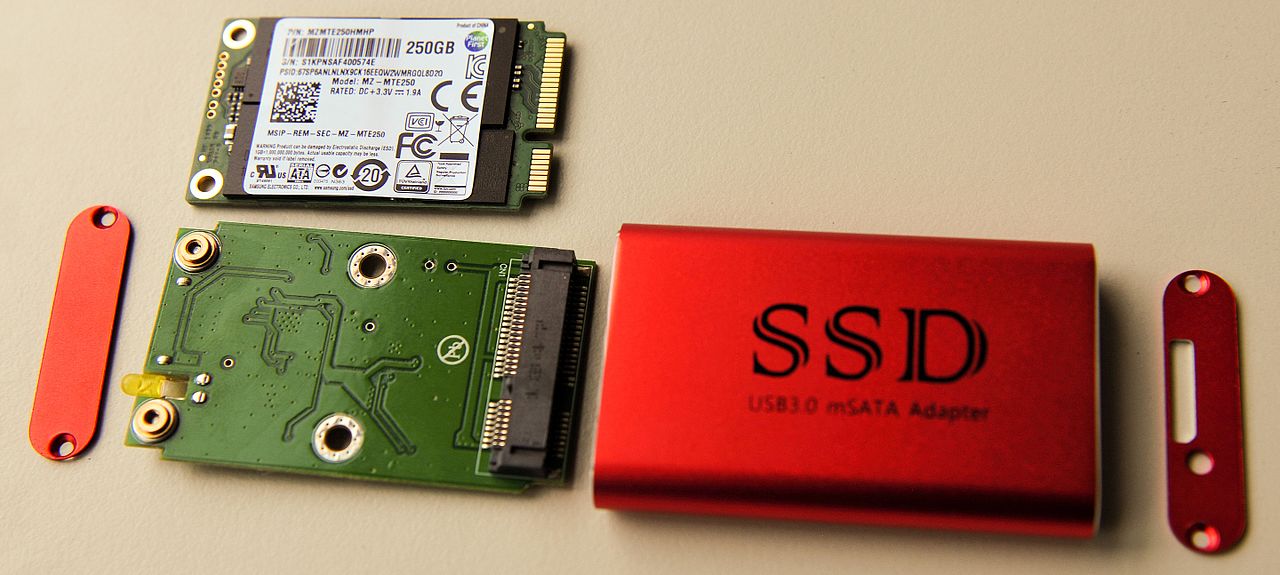
Thesolid state drive are based onflash memory usually of type NAND for data storage, i.e. they exploit the tunnel effect to modify the electronic state of transistor cells; for this reason they do not require moving mechanical parts (discs, motors and heads), nor magnetic components, which brings significant advantages to the reduction of electrical consumption and wear.
The memory of SSDs is usually of type NAND 2D (single layer) or 3D (multilayer or V-NAND), a technology that can differentiate itself in Single Level Cell (SLC), Multi Level Cell (MLC), Triple Level Cell (TLC) e Quad Level Cell (QLC) depending on the number of bits per cell and consequently on the voltage levels it can assume; these memories undergo wear and lose precision of the voltage level, generating a greater load on the algorithm error-correcting code (ECC).
Another characteristic of flash memories lies in their small physical dimensions which allow the creation of extremely compact and lightweight SSD units, therefore easily integrated into ultra-thin mobile devices.
In addition to the memory itself, an SSD has several components necessary to manage its operation.
An SSD consists of a controller, a cache memory, a supercapacitor, an interface.
Thecontroller consists of a microprocessor which is responsible for coordinating all the operations of the mass memory. The software thet governs this component is a firmware pre-installed by the manufacturer. In addition to reading/writing operations, it manages:
Error-correcting code: checking and correcting errors during reading/writing
Wear leveling: writing distribution evenly across the entire drive
Bad block: Transparent bad sector detection and reallocation with spare blocks
Cache memory: internal to the device
Garbage collection: automatic detection and reduction of fragmentation of the internal disk organization
Data encryption: for the protection of stored data.
LBA (logical block address) scrambler: experimental technique that exploits fragmented data pages to reduce the number of writes and deletions.
The Cache memory is a memory, depending on the level to which it belongs, usually in the order of a few MB depending on the type of system and generally proportional to the capacity of the SSD, used by the processor to temporarily store information that will be requested later by the system. It is then filled and emptied many times. This cache can be of various types:
ThroughDRAM memories , just like in mechanical disks (HD) the cache is a very fast and volatile memory
ThroughROM memory,technique used on some economical SSDs, characterized by cells NAND SLC
Mixed or dual-cache, use of both systems (DRAM+ROM), it is a two-level cache, which allows an extremely versatile and elaborate cache management system.
A novelty introduced by solid state memories is the possibility of terminating writing operations even in the event of a power failure. This happens thanks to the presence of a supercapacitor or, more rarely, a backup battery, which guarantees sufficient energy to complete the current operation. This technique allows you to guarantee greater data integrity and prevent the file system from being corrupted.
The connection can be made with cables of type SATA, both in terms of data connection and power supply. Ultimately it is possible to connect an SSD using a normal interface SATA2 (3Gb/s) or SATA3 (6Gb/s). There are also SSDs that use the interface PCI Express; the latter can reach a transfer speed of 21Gb/s.
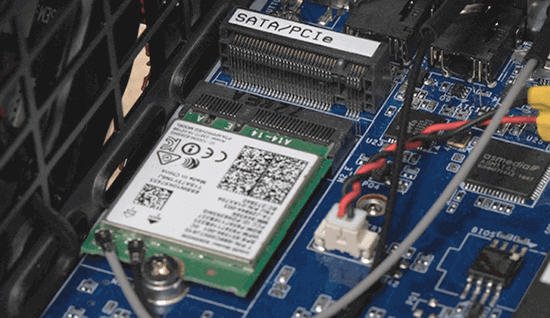
What are the advantages of using a SSD?
- The total absence of moving mechanical parts brings various advantages, the main ones of which are:
- No noise, as there are no rotation components (motor and magnetic disk), unlike traditional HDDs;
- Lower chance of failure: Solid state drives on average have a lower failure rate than hard drives. This rate fluctuates between 0.5% and 3%, while in hard disks it can reach 10% (the MTBF, usually reaching 2,000,000 hours for a latest generation SSD);
-Lower electricity consumption during reading and writing operations;
- Reduced access and storage times: working in the order of tenths of a millisecond[13]; the access time of magnetic disks is over 50 times greater, remaining between 5 and 10 milliseconds;
- Greater data transfer speed;
- Greater impact resistance: the specifications of some manufacturers go as far as declaring resistance to impacts of 1500 g;
- Less heat production;
theSSD SATA they have the exact same shape, size and connection interface as 2.5" SATA hard drives and are therefore interchangeable with them without installing specific hardware or software components (some UEFI settings may be necessary to fully exploit their data transfer speed ).
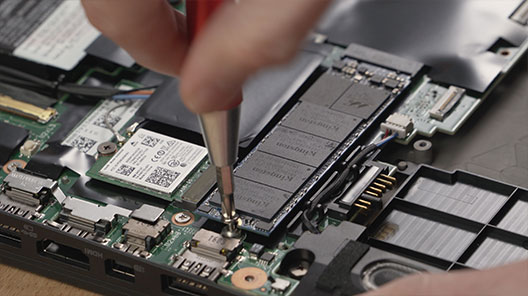
Compared to greater shock resistance and lower consumption, solid state drives have two main disadvantages:
- Higher price, i.e. less storage capacity for the same cost compared to hard disks.
- Worse data retention when not powered and in a different way depending on the exposure temperature.
However, these problems seem destined to be resolved in the future. New technologies are bringing flash memories capable of guaranteeing a life equal to or greater than that of a traditional hard disk and currently manufacturers declare 140 years of life with 50 GB of rewrites per day on a 250 GB drive[14]. All thanks to the introduction of particular techniques, such as the use of carbon nanotubes.
A progressive replacement of traditional disks with solid state drives is underway.
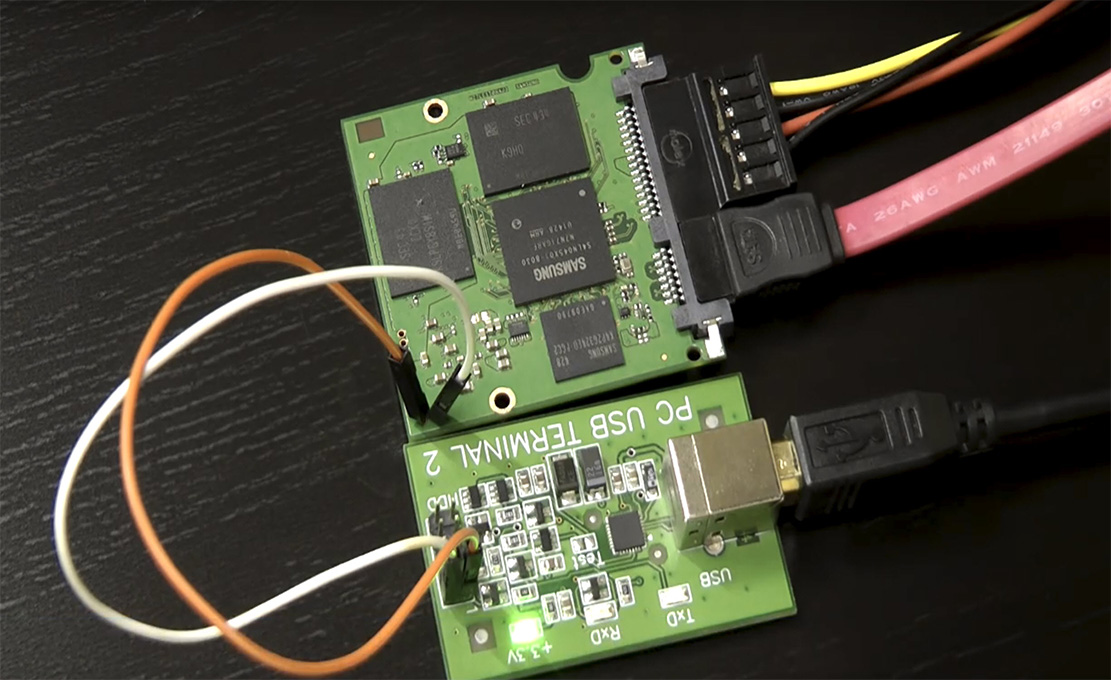
An element that immediately comes to light by analyzing the performance of a device SSD is the lower writing speed compared to reading speed and its strong variability depending on the size of the files you want to write. This depends on the fact that while the file systems of Operating Systems usually use cell blocks with a size of 4 KiB, in SSD devices the size of the blocks is much higher (for example 4 MiB).
This means that to write a cell we must first read the entire block, then write over the desired cell leaving the others unchanged and finally save it. It follows that if we have to write more cells (larger files) performance improves, because by reading and then saving a block, we can write as many cells into it at the same time as there are free ones available. One way to improve performance is to know free blocks (with no cells used); To achieve this, the latest generation operating systems provide the TRIM command, which communicates to the SSD controller which blocks are unused and deletes the cells directly when deleting the files, thus improving performance
Thedisk fragmentation SSD it does not affect its performance, since the access time to any cell is identical; modern operating systems therefore disable disk defragmentation (in all operating systems Microsoft Windows, however, scheduling must be deactivated, otherwise defragmentation will still be scheduled), as it is not only useless, but even harmful as it negatively affects the life of the disk itself. In fact, precisely to increase the duration of the support, we try to reduce the overload on a cell by continuously rewriting it, thanks to the help of a controller that distributes the data during writing, trying to exploit the entire disk and avoiding leaving unused parts. On the contrary, defragmentation would only increase the number of data writing cycles, shortening the life of the disk itself.
Do you have a problem with one of these devices?
MrDisk is a Specialized Laboratory inData Recovery equipped with all the necessary equipment to allow the restore lost data from any type of case presented to us.
.jpg)
In our laboratories only operatespecialized technicians and with years of experience in the field of professional data recovery ,to offer our customers the best possible service.
Some important features:
- Possibility to have a dedicated technician to your case
- Constant research and development activity
- Specialized technicianson individual media or brands
- Possibility of even extreme interventions in a clean room
- Possibility of receiving updates, in real time, on the progress of the processing
Total data recovery is possible in the following cases:
- Logical damage (software): where the media is still recognized by the system BIOS.
- Physical damage, whether electrical, electronic or mechanical (hardware): in which the media is or not longer recognized by the BIOS.
The procedure ofdata recovery in clean room is divided into two steps: the diagnosis steps and the data recovery procedure.
The customer is constantly informed about the status of data recovery.
Request a free analysis by clicking on the page contact us!
-
Dischi Esterni USB con...
